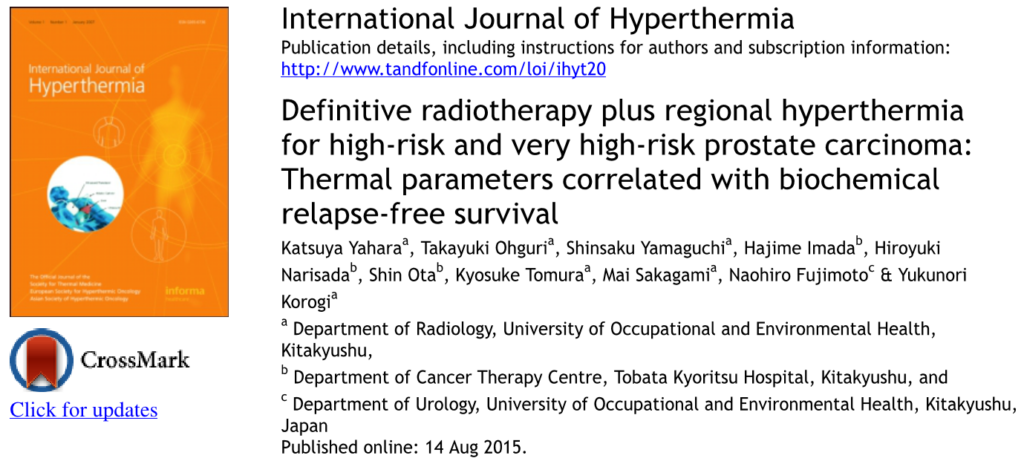Radykalna radioterapia w połączeniu z hipertermią u pacjentów z rakiem prostaty wysokiego i bardzo wysokiego ryzyka: parametry termiczne w korelacji z przeżywalnością biochemicznie wolną od nawrotów
tytuł oryg.: Definitive radiotherapy plus regional hyperthermia for high-risk and very high-risk prostate carcinoma: Thermal parameters correlated with biochemical relapse-free survival
Wydawnictwo: International Journal of Hyperthermia
Autor główny: Katsuya Yahara
Pozostali autorzy: Takayuki Ohguri, Shinsaku Yamaguchi, Hajime Imada, Hiroyuki Narisada, Shin Ota, Kyosuke Tomura, Mai Sakagami, Naohiro Fujimoto, Yukunori Korogi
Data: 2015-08-14

DOI: 10.3109/02656736.2015.1062214
Język publikacji: angielski
Klasa publikacji: Badanie retrospektywne
Rodzaj badania: Nierandomizowane
Liczba pacjentów: 146
Rodzaj HT: LRHT Capacitive
Rodzaj HT opis: Hipertermia miejscowa głęboka metodą pojemnościową
Aparatura: Termotron-8
Jednostka chorobowa: Rak prostaty wysokiego/b. wysokiego ryzyka
Symbol Jednostki chorobowej: –
Stage: High risk/very high risk
Typ skojarzenia HT stosowany w badaniu: HT + RT
Rodzaj CT: –
Abstract. Purpose: The aim of this study was to assess the efficacy of definitive radiotherapy (RT) plus regional hyperthermia (HT) and investigate the potential contribution of HT to clinical outcomes in patients with prostate carcinoma.
Materials and methods: Following our institution’s treatment protocol, HT was combined with RT to improve clinical outcomes in selected patients with high-risk or very high-risk prostate cancer. Data from 82 patients treated with RT plus HT and 64 patients treated with RT alone were retrospectively analysed.
Results: Median follow-up duration was 61 months. The 5-year biochemical disease-free survival (bDFS) rate for the 82 patients treated with RT plus HT was 78%, whereas bDFS for the 64 patients treated with RT alone was 72%; this difference was not significant. Among the 75 patients treated with RT plus HT who underwent intra-rectal temperature measurements, higher thermal parameters were significant prognostic indicators of improved bDFS by univariate analysis. A higher CEM43 CT90 thermal parameter and a T stage of T1–2 were significant prognostic factors based on multivariate analysis. The 5-year bDFS rates for the 40 patients with a higher CEM43 CT90 and the 64 patients treated with RT alone were significantly different, whereas 5-year bDFS for the 35 patients with a lower CEM43 CT90 and the 64 patients treated with RT alone were not.
Conclusions: The addition of HT with higher thermal parameters to RT may improve bDFS for patients with high-risk or very high-risk prostate cancer. These findings also demonstrate the importance of careful selection of treatable patients with higher thermal parameters.
Potrzebujesz więcej danych o artykule? Skontaktuj się z PTHO droga mailową.